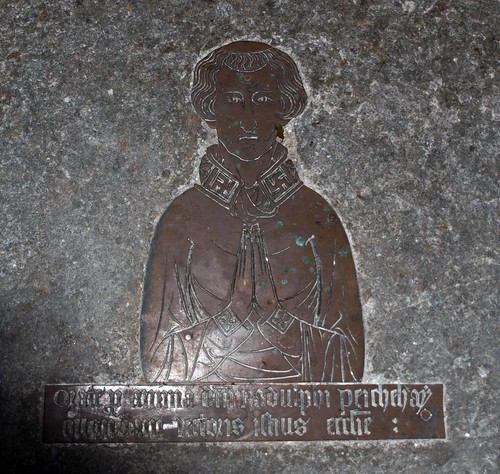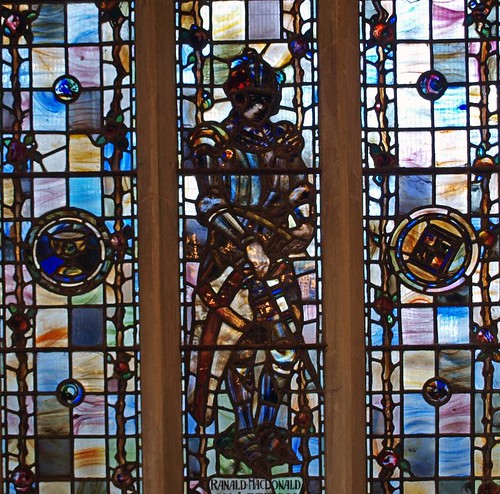ST MARY. Square, short C13 W tower with hipped spire. Steep primitive stair inside. Nave with two-bay S arcade also C13 (circular pier, double-chamfered broad, depressed pointed arches). The responds more remarkable than the pier, especially the E respond with a head corbel, and original colouring; fine mouldings. Late C13 the S chancel chapel with lancet windows with cusped rear-arches inside. Sign of an earlier Norman past the plain N doorway. - PULPIT. 1611, of the type then usual. - HOURGLASS STAND, C17, wrought iron, fixed to the Pulpit. - DOOR, on the N side with some C13 ironwork. - PLATE. Cup and Cover of 1627; Flagon 1665; Paten on foot 1683. - Many BRASSES, e.g. Ralph Perchehay, rector of Stifford, large demi-figure of c. 1380; John Ardalle d. 1504, and wife.
STIFFORD. It is a quiet place on a hill, with thatched cottages and rich woodlands with the Mardyke in the valley where men lived two thousand years ago. Samian ware of the Romans found here is in the Geological Museum, and a bronze sword has been discovered in the bed of the stream.
The memorial to the heroes of the village tells how they left all that was dear to them, and very dear must have been this church with the shingled spire, a bell projecting quaintly from its side. The plain doorway was built by the Normans; its 16th century door has crescent hinges with scroll-shaped ends, and other ironwork wrought about the time of Magna Carta. Very charming are the lancet windows, but the gems in stone are the heads at each end of the arcade, both delicately carved. The one near the chapel is painted red, with the hair and crown in gilt. The short round column and the moulded capital above this beautiful head is decked with black and red, a glowing note of colour. The face is looking at a window in which is the strongly-drawn figure of a warrior saint in memory of an army officer who died in 1927; it is the work of Leonard Walker.
The simple square font with tapering sides is 700 years old. The oak pulpit was elaborately carved in 1611, and has an hourglass stand. Two lovely chairs were carved at the end of the 17th century.
In bold square lettering in the chancel is recorded the burial of David de Tillebery, who lived 600 years ago, and a portrait in brass shows a rector of 1380, Ralph Perchehay, wearing a collar with the famous Greek pattern, the left-handed swastika. Portraits of later worshippers are in the chapel of the lords of the manor. In a long fur gown lies John Ardalle, who died in 1504, his wife beside him, and shields with bulls and starfish. There are four 17th century members of the Lathum family, Suzan looking very quaint in her conical hat, ruff, and farthingale. Early 18th century cherubs weep in the tower for Sir Nathaniel Grantham, his wife, and his daughter, and there are monuments to the Silverlocks, who lived in a delightful house a mile away, Ford Place, with 1655 on a Dutch gable. Two of the rooms have magnificent plastered ceilings, one of them, with rosettes, bay leaves, and oak leaves, fruits, flowers, and figures of the seasons, being a gorgeous masterpiece of its age.
The memorial to the heroes of the village tells how they left all that was dear to them, and very dear must have been this church with the shingled spire, a bell projecting quaintly from its side. The plain doorway was built by the Normans; its 16th century door has crescent hinges with scroll-shaped ends, and other ironwork wrought about the time of Magna Carta. Very charming are the lancet windows, but the gems in stone are the heads at each end of the arcade, both delicately carved. The one near the chapel is painted red, with the hair and crown in gilt. The short round column and the moulded capital above this beautiful head is decked with black and red, a glowing note of colour. The face is looking at a window in which is the strongly-drawn figure of a warrior saint in memory of an army officer who died in 1927; it is the work of Leonard Walker.
The simple square font with tapering sides is 700 years old. The oak pulpit was elaborately carved in 1611, and has an hourglass stand. Two lovely chairs were carved at the end of the 17th century.
In bold square lettering in the chancel is recorded the burial of David de Tillebery, who lived 600 years ago, and a portrait in brass shows a rector of 1380, Ralph Perchehay, wearing a collar with the famous Greek pattern, the left-handed swastika. Portraits of later worshippers are in the chapel of the lords of the manor. In a long fur gown lies John Ardalle, who died in 1504, his wife beside him, and shields with bulls and starfish. There are four 17th century members of the Lathum family, Suzan looking very quaint in her conical hat, ruff, and farthingale. Early 18th century cherubs weep in the tower for Sir Nathaniel Grantham, his wife, and his daughter, and there are monuments to the Silverlocks, who lived in a delightful house a mile away, Ford Place, with 1655 on a Dutch gable. Two of the rooms have magnificent plastered ceilings, one of them, with rosettes, bay leaves, and oak leaves, fruits, flowers, and figures of the seasons, being a gorgeous masterpiece of its age.



No comments:
Post a Comment